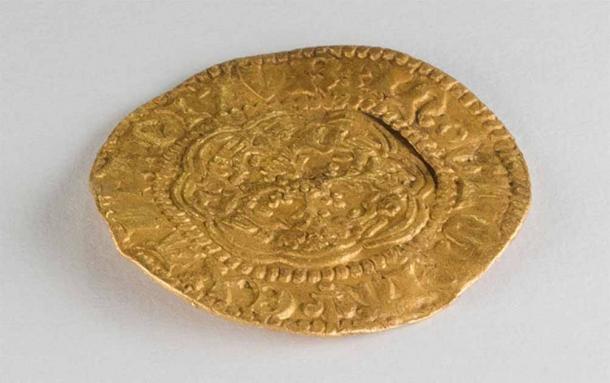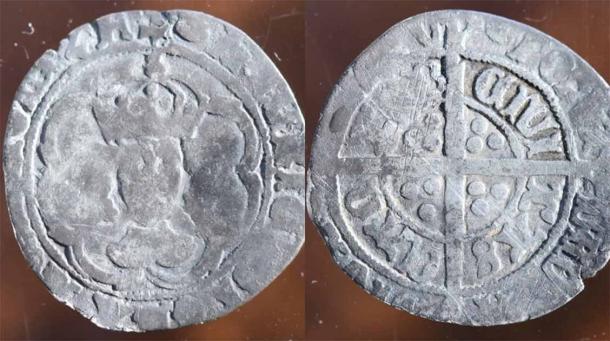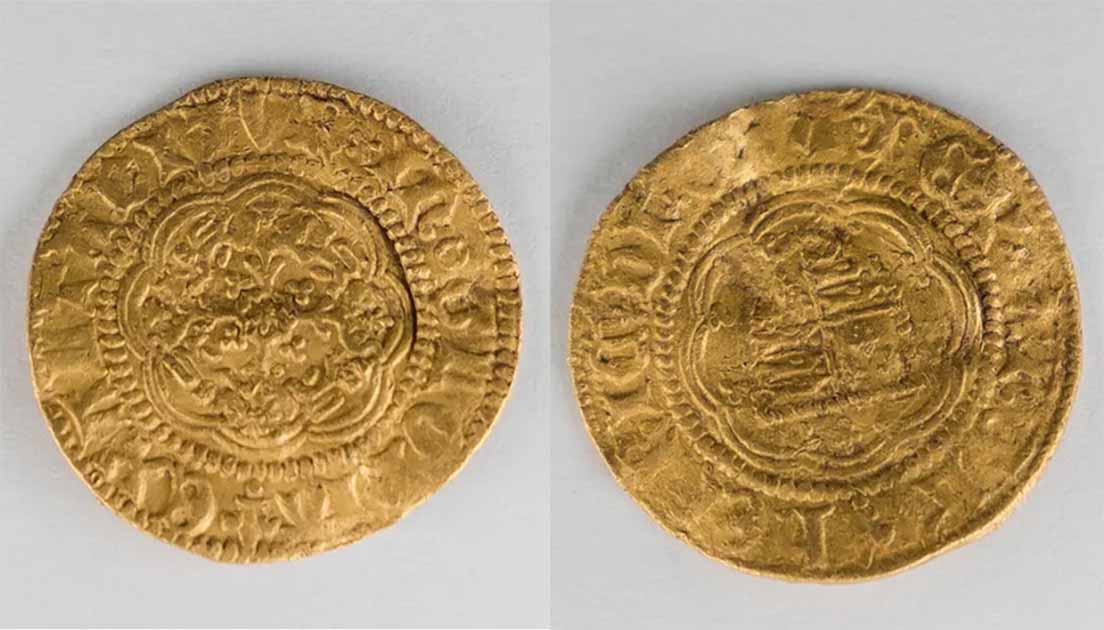Medieval Coin in Canada Challenges Story of North American Discovery
A gold coin discovered in Newfoundland could “rewrite the history books.” Directly challenging the mainstream narrative of the discovery of North America, this coin suggests Europeans were in Newfoundland earlier than currently believed.
Exciting Discovery of Medieval Coin in Canada
This week the Government of Newfoundland and Labrador published a press release saying the controversial gold coin was found this summer by Edward Hynes, a local amateur historian. Heralded as the oldest English coin ever discovered in Canada, this quarter noble was minted in London sometime between 1422 AD and 1427 AD, at which time it was valued at one shilling and eight pence, around $81 today.
- Silver Coin from Henry VII’s Reign is Oldest English Coin Found in Canada
- The Beothuck Key: Finding a Lost Chinese-Norse Civilization in Canada
Because this medieval coin was discontinued around 1470 AD, its discovery on a Canadian beach is presenting archaeologists with “a historical puzzle.” Is this coin the smoking gun proving European occupation in North America earlier than currently thought?

A Henry VI quarter noble, a medieval coin unearthed in Canada which was originally minted in London between 1422 and 1427. (Government of Newfoundland & Labrador)
The Big North American Discovery Question
Medieval Icelandic sagas said Leif Erikson rediscovered North America in 1001 AD, but archaeologists always disregarded these accounts as being mythological. However, that all changed in 1978 when archaeologists discovered an 11th century Norse settlement at L’Anse aux Meadows in Canada.
According to accepted history, the next European explorer in Newfoundland arrived in 1497 AD. This was John Cabot, the Italian navigator credited with the rediscovery of Newfoundland. However, the newly discovered medieval gold coin found in Canada predates John Cabot's voyage by 70 years.
Jamie Brake, a Canadian Provincial archaeologist told CBC News that according to the accepted historical narrative, at the time this coin was minted “people in England were not yet aware of Newfoundland or North America,” and that is why the discovery is “so exciting.”
The researcher added that evidence of a pre-16th century occupation of the New World would be “pretty amazing and highly significant in this part of the world.” This was a humble statement, for, in reality, such a discovery would demand a rewriting of the history, defaming John Cabot, and telling an entirely new origins story.
The Oldest English Medieval Coin Uncovered in Canada
This quarter noble gold coin dates back to the reign of King Henry VI in the 1420s AD. Thus, it is older than the “half groat” coin that was unearthed last year on the beach at the Cupids Cove Plantation provincial historic site, which dates to the 1490s.

The Henry VII “half groat,” or two-penny piece, minted in Canterbury, England sometime between 1493 and 1499 and discovered at the Cupids Cove Plantation Provincial Historic Site in Canada’s Newfoundland in 2021. (Government of Newfoundland and Labrador)
Because this is the oldest coin ever discovered in Canada, the location where it was discovered has not been disclosed for security reasons. Brake told CBC News that everyone concerned is being “really vague about the location.” However, he did disclose that it was “found on a beach near a registered archaeological site that dates to the 1700s .”
According to Paul Berry, the former curator of the Bank of Canada's Currency Museum, the mystery of how the medieval coin came to be where it was discovered “is likely to remain for some time.” Berry said that while the coin was probably no longer in circulation when it was lost “that doesn't help provide answers as to how it got there.”
While Paul Berry suggests it was dropped “after” it was out of circulation, archaeologist Brake suggests it might have been dropped by someone “before” Italian explorer Cabot got here in 1479 AD. Who then might have dropped the gold coin before Cabot’s official discovery of North America 1497 AD?

Statue of John Cabot gazing across Bonavista Bay from Cape Bonavista, the place where, according to tradition, he first sighted land on the northeast coast of the island of Newfoundland. (Evan T. Jones / CC BY-SA 4.0)
Who Rediscovered North America? Elite Explorers, or Fishermen?
According to Newfoundland Heritage, in 1481 AD English merchant John Day sailed one of two Bristol ships, the George and the Trinity, in search of the mythical island known as Brasile. Suspiciously loaded with salt, it is suspected the two boats had possibly discovered the cod-filled Grand Banks of Newfoundland, one of the world's richest fishing grounds.
- Vikings Didn’t Just Pop into Canada for a Visit, They Stayed for Centuries
- 4,000-Year-Old Butchered Bones Found in Canada Change Known History of North America
In a letter written by John Day to the anonymous “Lord Grand Admiral,” who many believe was Christopher Columbus, the merchant said the land John Cabot discovered was “the mainland that the Bristol men found” in 1481. And so far as to why Day didn’t announce his discovery is concerned, it is thought that he might have tried to keep the whereabouts of the bountiful fishing grounds a secret for as long as possible.
Might one of the hundreds of Bristol merchants and navigators who sailed in the western sea before John Cabot have landed in Newfoundland? If so, did they perhaps acquire something from an indigenous trader and leave a gold coin behind? The questions are many, but for now, there stands a chance this medieval coin is the smoking gun providing evidence of pre-Cabot Europeans in North America.
Top image: Both sides of the medieval coin found in Canada, a Henry VI quarter noble minted in London between 1422 and 1427. Source: Government of Newfoundland & Labrador
By Ashley Cowie




















Comments
I don't see any evidence in the article for the proposition that the subject coin was minted in London sometime between 1422 AD and 1427 AD.” According to https://coins.ha.com/itm/great-britain/great-britain-henry-vi-1st-reign-..., Henry VI quarter nobles were “struck intermittently from 1422-60.”
I would agree that “the coin was probably no longer in circulation when it was lost.” However, I do not accept the statement as probative of the date when it was brought to Newfoundland.
Quarter nobles were indeed minted during the reign of Henry VI, but the article fails to support the proposition that this one was minted “in the 1420s.” Perhaps there are style points that would establish that, but if so they are not apparent here. Henry VI (as a baby) became king in 1422, but his first reign lasted until 1460. He returned to the throne in October 1470 and ruled about 7 ½ months, when he was murdered (presumably on orders of Edward IV). Thus a coin issued in the name of Henry VI could have been minted as late as 1471 – only ten years before the Bristolmen landed in Newfoundland – and certainly through 1460.
If it was indeed minted about 1422, no matter. Gold coins are very durable. I have in my own stash several coins older than 130 years, and I’m not even a real coin collector as such.
Even if the quarter nobles under the name of Henry VI were officially “taken out of circulation” in 1460 upon the Yorkist takeover, that doesn’t mean that the Treasury would have succeeded immediately in acquiring all Henry VI coinage and melting it down right away.
Accordingly, I see no reason why John Day and his fellows would not have felt free to bring the quarter noble along as a token for trading on their voyage, no matter whom they might encounter. Or if the Day party didn’t bring it, and John Cabot did, the date of the coin would not establish that any Englishmen were in Newfoundland previously.
While the find is intersesting and the coin beautiful, I’d bet there’s a post-Cabot coin collector really upset about losing these coins.
Love Learning the Previously Unknown
TheMrTTT
The oft-repeated phrase, "Where there's a will there's a way" would be better the other way around. If there was a way, there was likely the will to go with it. That doesn't prove it happened, but it does make one more open to the possibility that it did.